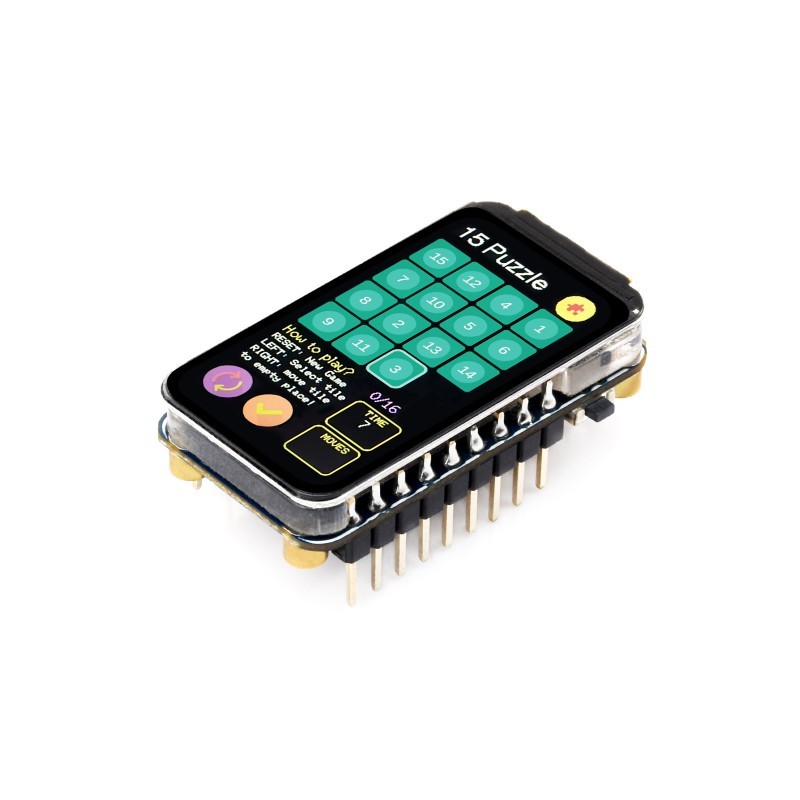






zł40.32 tax excl.
RP2350-LCD-1.47-A-M is an integrated development platform with a USB Type-C port and pre-soldered headers, enabling the creation and testing of applications based on the modern RP2350A microcontroller. Featuring an LCD display, large memory capacity, and the ability to choose between ARM and RISC-V architectures, the module is suitable for educational projects, embedded systems, and IoT solutions.
The RP2350-LCD-1.47-A-M module is a compact development board based on the RP2350A microcontroller, equipped with a 1.47" LCD display with a resolution of 172×320 pixels and support for 262K colors. The dual-core chip with dual architecture combines ARM Cortex-M33 cores with open-source Hazard3 RISC-V cores, enabling flexible development environments. A USB Type-C connector provides modern and convenient power and programming. The board also includes a TF card slot, 16 MB of Flash memory, BOOT and RESET buttons, and a built-in RGB LED with an acrylic panel for lighting effects. Pre-soldered header pins allow for fast peripheral connections.
Data sheet
Manufacturer BTC Korporacja sp. z o. o. Lwowska 5 05-120 Legionowo Poland sprzedaz@kamami.pl 22 767 36 20
Responsible person BTC Korporacja sp. z o. o. Lwowska 5 05-120 Legionowo Poland sprzedaz@kamami.pl 22 767 36 20
The RP2040 microcontroller board features two 133 MHz ARM Cortex-M0+ cores and 264 kB of RAM. The board also includes 2 MB of QSPI Flash memory. The chip can be programmed in C/C++, CircuitPython or MicroPython. DFRobot DFR0959
The RP2040 MCU board combines the high performance of two ARM Cortex M0+ cores clocked at up to 133 MHz, with 264 KB of SRAM, 2 MB of Flash, and integrated Bluetooth 5.1 for easy wireless communication. With simple programming, multiple GPIO interfaces, and support for C/C++, MicroPython, and Arduino, the board is ideal for IoT projects and other advanced applications. Waveshare RP2040-BLE
RP2350-Plus without headers is a universal development board designed for developers who prefer surface-mount soldering or custom connector configurations. Thanks to a large number of peripherals, a powerful chip, and full compatibility with the Raspberry Pi Pico, it provides a solid foundation for developing consumer, educational, and professional electronics projects.
Mechanical keyboard module with LED backlight, encoder and display. Based on the RP2040 microcontroller. Adafruit 5128
RP2350-Touch-LCD-1.69 is a compact and versatile development board offering advanced processing capabilities thanks to its dual-core CPU architecture and large Flash memory. The integrated touchscreen, sensors, and battery power support make it an ideal choice for HMI projects, wearable electronics, measurement systems, and educational solutions based on the RP2350.
The board with the RP2040 microcontroller equipped with two ARM Cortex-M0 + cores operating at 133 MHz, 256 kB RAM. The board also has 16 MB of QSPI flash memory. The system can be programmed in C/C++ or microPython. SparkFun DEV-18288
Evaluation board with a Raspberry Pi RP2040 microcontroller and a TCP/IP W5500 controller. WIZnet W5500-EVB-PICO
An enhanced version of the Raspberry Pi Pico 2 with access to all 48 GPIO pins and an RP2350B microcontroller (Cortex-M33 or RISC-V) clocked at up to 150 MHz. It offers 16 MB of Flash, 8 MB of RAM, and a microSD card reader, making it ideal for complex embedded and IoT projects. With USB-C, Qwiic/Stemma Qt, UEXT connectors, and BOOT/RESET buttons, it offers high flexibility and easy integration with peripherals. Olimex RP2350-PICO2-XXL
Development board with RP2040 microcontroller. Equipped with a driver for DC motors, servos and Grove connectors. Dedicated to the construction of robots. Cytron MAKER-PI-RP2040
RP2350-Touch-AMOLED-1.64-M is a compact board featuring the RP2350 microcontroller and an AMOLED display, equipped with touch input, motion sensors, and a full set of peripheral interfaces. Designed for modern mobile applications, HMI systems, and experiments with RISC-V and ARM architectures.
RP2350-LCD-1.28-B is a highly integrated development platform with a display, designed for applications requiring low power consumption and high flexibility in interface design. Thanks to its robust CNC enclosure and support for two processor architectures, the module is perfectly suited for use in portable systems, HMI devices, and intelligent embedded projects.
RP2350-LCD-0.96-M is a versatile development board with a display, designed for projects based on RP2350A microcontrollers. It supports multiple interfaces and programming languages, features pre-soldered headers, and is compatible with Pico HAT modules, making it ideal for prototyping embedded systems, portable devices, and educational projects.
Board with the RP2040 microcontroller equipped with two ARM Cortex-M0+ cores and a 5x5 RGB LED matrix. There is also 2 MB of QSPI flash memory on the board. The circuit can be programmed in C/C++ or MicroPython. Waveshare RP2040-Matrix
Mini board with RP2040 microcontroller equipped with two ARM Cortex-M0 + 133 MHz cores, 264 kB RAM. The board also has 8 MB of QSPI flash memory. The circuit can be programmed in C/C++, CircuitPython or MicroPython. Pimoroni SP011
No product available!
Module with LCD 2.4" display with a resolution of 320x240 px and RP2040 microcontroller. Equipped with QW/ST connector. Pimoroni PIM624
CAN 2.0 module based on the MCP2551 and MCP2515 systems, equipped with the RP2040 microcontroller. Seeed Studio 102991596

RP2350-LCD-1.47-A-M is an integrated development platform with a USB Type-C port and pre-soldered headers, enabling the creation and testing of applications based on the modern RP2350A microcontroller. Featuring an LCD display, large memory capacity, and the ability to choose between ARM and RISC-V architectures, the module is suitable for educational projects, embedded systems, and IoT solutions.
